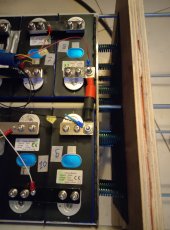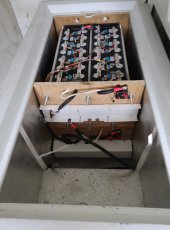Eve specifies 3/8" (9mm) for end plates. That said, I also used 1/4" (6mm).I'll go with 6mm plates
You are using an out of date browser. It may not display this or other websites correctly.
You should upgrade or use an alternative browser.
You should upgrade or use an alternative browser.
Compress or not, flexible busbar or not
- Thread starter Cheap 4-life
- Start date
7075 is the strongest, stiffest and machines very nice. It can’t be bent, if attempted it will fracture or be very compromised. Welding shouldn’t be attempted because it’s very likely to crack. It also has the highest corrosion potential because of the high zinc content which is also the thing that makes it weld terrible. I use it as a stiffener inside the bottom of plastic battery boxes with a few layers of Kapton tape so cells don’t sag and shift. Stiffer and cheaper than carbon fiber for dimensions, but heavier. On average I convert 30 pounds of the stuff into chips a day making parts from billet. I love how it machines, just sprays away, never gums up the tool.7075 has the highest tensile strength. I'll go with 6mm plates. If the cells manage to bend it then it is probably time for new cells. Or at least this is the impression I'm getting after going over the full thread.
SolaroSsaurius
New Member
- Joined
- Aug 27, 2022
- Messages
- 171
The specification is for 10mm:Eve specifies 3/8" (9mm) for end plates. That said, I also used 1/4" (6mm).
The single cell needs to be clamped with steel splints or aluminum alloy splints (thickness: 10 mm). The splints
3.3. Testing Clamp Preparation
need to cover the large surface of the cell. The splints are fixed with 6 M6 bolts. All sides of the splints need to be
covered with insulating film
SolaroSsaurius
New Member
- Joined
- Aug 27, 2022
- Messages
- 171
(thought I've seen lots of builds with 6mm, and I haven't seen anyone complaining)
And nobody complains from 3/4" plywood. But I suspect that it may sag with time.
I'll check on Monday the prices for 7075 sheets and if they are sane - I'll go with it. If not - with plywood. The reason why I'm expecting high a price is that I'll likely have to buy a 150cm x 21cm piece and the prices have gone crazy around since the war in Ukraine started.
I'll check on Monday the prices for 7075 sheets and if they are sane - I'll go with it. If not - with plywood. The reason why I'm expecting high a price is that I'll likely have to buy a 150cm x 21cm piece and the prices have gone crazy around since the war in Ukraine started.
And nobody complains from 3/4" plywood. But I suspect that it may sag with time.
Yes 3/4” Sande or Radiata pine plywood will bend in less than a month, however laminating an additional layer of 1/2” is enough to keep the bulge/flex less than .015”. Use Radiata pine from Loews because the veneer is thicker than the Sande pine.
Yes it’s very strong. Solid birch is what many modeler make their main wing spars from. It’s not cheap here. What the different internal plies are made from and quality of adhesives is always a concern of what ever you buy anywhere. Some years ago I bought marine grade plywood and I had drops left out in the rain over the weekend. When I was cleaning up, I noticed the glue had delaminated! Talking to other builders I found out that in order to make it more environmentally friendly they had gone to another adhesive and hadn’t tested it enough. Glad it wasn’t for a boat hull.I'm in east Europe. What I can get here is birch plywood. If I'm reading it correctly it is stronger than the radiata pine one.
SolaroSsaurius
New Member
- Joined
- Aug 27, 2022
- Messages
- 171
In East Europe alu prices are now insane!!I'm in east Europe. What I can get here is birch plywood. If I'm reading it correctly it is stronger than the radiata pine one.
And I just found one local seller selling 10mm sheets... 1500x2000mm !!
Where are you located?
How are prices around your place?
Ron-ski
Solar Enthusiast
In the UK I bought 200mm x 10mm Aluminium Flat Bar - 800mm length, and it was £48. Prices here have gotten ridiculous, my build has cost far more than I thought it would.
SolaroSsaurius
New Member
- Joined
- Aug 27, 2022
- Messages
- 171
For those in Europe, I noticed this catalog:
pg. 54, spring # 61162
For those wanting to use M6 and 6 rods on a single LF280k row:
Size 51mm
Rate 128/mm
Compressed at 5,1mm -> 653N
Compressed at 6,1mm -> 783N
Seems fine to my inexperienced eye.
It will make
- 490N compressed at 3,8mm (around 12psi)
- 694N compressed at 5,4mm (around 17psi)
I'm considering it for an 8 cells row, though still searching for more options.
Opinions?
PS: Even so, I'm still a bit reluctant in using springs, given the datasheet does not show the use of any in their testing procedures!!! Just fixed rods compressing to 300kgf at 30% - 40% SOC
pg. 54, spring # 61162
For those wanting to use M6 and 6 rods on a single LF280k row:
Size 51mm
Rate 128/mm
Compressed at 5,1mm -> 653N
Compressed at 6,1mm -> 783N
Seems fine to my inexperienced eye.
It will make
- 490N compressed at 3,8mm (around 12psi)
- 694N compressed at 5,4mm (around 17psi)
I'm considering it for an 8 cells row, though still searching for more options.
Opinions?
PS: Even so, I'm still a bit reluctant in using springs, given the datasheet does not show the use of any in their testing procedures!!! Just fixed rods compressing to 300kgf at 30% - 40% SOC
Bulgaria. They were insane in May. I'll get my quotes on Monday for the ALU 7075 plates. I may go for steel if they are too high or just go with the plywood.Where are you located?
How are prices around your place?
For the springs - I built a 12V/105Ah in May this year. Back then I did research on where can I get springs from. I ended up with a cheap construction store selling many springs. No load ratings on them, but I got a few that were looking good and tests confirmed that they are good to go. Outer diameter is 15mm, inner is 10mm. The cheap ones are less than a dollar, and the expensive ones (certified, with load ratings) are 8-15 dollars (depending on what you choose).
Last edited:
For those in Europe, I noticed this catalog:
pg. 54, spring # 61162
For those wanting to use M6 and 6 rods on a single LF280k row:
Size 51mm
Rate 128/mm
Compressed at 5,1mm -> 653N
Compressed at 6,1mm -> 783N
Seems fine to my inexperienced eye.
It will make
- 490N compressed at 3,8mm (around 12psi)
- 694N compressed at 5,4mm (around 17psi)
I'm considering it for an 8 cells row, though still searching for more options.
Opinions?
PS: Even so, I'm still a bit reluctant in using springs, given the datasheet does not show the use of any in their testing procedures!!! Just fixed rods compressing to 300kgf at 30% - 40% SOC
Not using springs in compression fixture. Just using yellow pine wood 1 inch x 10 inch cut to length and four 1/4 inch course threaded rods with 1/4 inch nuts & washers on the 8s Lifepo4 battery banks.
This is Info I used and torqued a little less at 5 Inch Pounds with a torque wrench at about 3.2 to 3.3 volts charge in each cell.
The spec from EVE was 300 KG force which rounds off to 660lbs. Battery face is approx 6.85"x 7.874" = 53.94 sq inches
660lbs/53.94sqin=12.23 lbs per sq inch
Divide 660 by 4 bolts that's 165 lbs Axial (clamping) force per bolt.
Using 4 course 1/4 in threaded rods that should equate to roughly 8 INCH pounds torque per bolt. Realistically, that's a snug twist of the wrist on a regular nut driver for the average build mechanic.
Bonjour,Bonjour @oliagri
Merci pour ce tableau.
je n'ai pas bien compris :
a) quelle est l'unité de mesure à l'intérieur des tableaux ? kgf ? N ?
b) Je ne comprends pas comment un ressort plus gros peut produire moins de force
c) quelle est la compression à laquelle il atteindra la force maximale spécifiée
Avez-vous plus d'infos sur ceux-ci ?
Merci d'avance
a : l'unité utilisée est le kgf (comme indiqué en bas du tableau)
b : à longueur égale un gros ressort a toujours plus de force qu'un petit (plus un ressort est long moins il faut de force pour la pastille d'un mm)
c : les efforts indiqués correspondent à une compression d'un mm. la compression n'est pas complètement linéaire. Je n'ai pas d'informations supplémentaires mais après avoir testé la force augmente légèrement au fil de la compression
Bonjour à tous., voici quelques photos de mon installation terminée.
liens vers mon installation en France
liens vers mon installation en France
Attachments
Tulex
Solar Wizard
I'm still going to read it to the end, I've come so far.This has got to be the most inane thread I have ever witnessed on this Forum.
Apologies to any poor newbies that have wandered into this morass this deep, but I’m out…
Ron-ski
Solar Enthusiast
I did the same, and in the end I decided to compress using Poron foam and use laminated flexible busbars.I'm still going to read it to the end, I've come so far.
A fridge?!? Are you cooling them down or heating them upBonjour à tous., voici quelques photos de mon installation terminée.
liens vers mon installation en France
MrM1
I'm Here, But I'm Not All There
Back on page 1 of this thread, Andy from the Off Grid Garage YouTube channel was referenced as saying why he would not compress. I wonder if Andy is having 2nd thoughts?
Ron-ski
Solar Enthusiast
I have watched all Andy's videos, but I wasn't convinced no compression was the correct way to go, so I compressed with foam and used flexible busbars.
Similar threads
- Replies
- 7
- Views
- 1K
- Replies
- 23
- Views
- 1K





